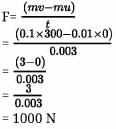Test: Class 9 Science: CBSE Sample Question Paper Term I - 2 - Class 9 MCQ
30 Questions MCQ Test - Test: Class 9 Science: CBSE Sample Question Paper Term I - 2
Statement A: The separation of constituents from the homogeneous mixture is easier as compared to the heterogeneous mixture.
Statement B: Milk can be regarded as a pure substance.
Which of the two statements is correct?
Statement B: Milk can be regarded as a pure substance.
Which of the two statements is correct?
Suppose a boy is enjoying a ride on a merry-go-round which is moving with a constant speed of 10ms-1. It implies that the boy is
A 20 kg gun fires a bullet of mass 20 g with a velocity of 400 m/s. The action on the shoulder of the person per second by the gun is:
The membrane of the Golgi apparatus has connections with those of:
Find out the correct sentence:
A. Parenchymatous tissues have intercellular spaces.
B. Collenchymatous tissues are irregularly thickened at corners.
C. Apical and intercalary meristems are permanent tissues.
D. Meristematic tissues, in its early stage, lack vacuoles.
What happens on adding dilute HCl to a mixture of iron filling and sulphur powder?
A. H2S is formed
B. A colourless and odourless gas is formed
C. A greenish solution appears
D. FeS is formed
Which of the following statement is correct?
A. When a body starts from rest, u = 0
B. When a body comes to rest, v = 0
C. For a body under free fall, a = -9.8m/s2
D. For uniform velocity, a = 0
In a football and a stone of the same size, the inertia of
A. Football is greater
B. Football is lesser
C. Stone is greater
D. Stone is lesser
The structure which forms a barrier between the protoplasm of the cell and its external environment in an animal cell is:
Eukaryotic cells have:
a. Distinct nucleus
b. Nucleolus
c. Nuclear membrane
d. Nucleoid
Brass is a homogeneous mixture of
In which of the following cases of motion, the distance moved and the magnitude of displacement are equal?
A bullet of mass 10 g is fired from a rifle. The bullet tales 0.003 second to move through its barrel and leaves it with a velocity of 300 m/s. What is the force exerted on the bullet by the rifle?
Which of the following is not a function of vacuole?
Where is the apical meristem found?
a. Root tip
b. Shoot tip
Which sublimate substance is used to protect warm clothes?
The membrane surrounding a vacuole in a plant cell is known as:
Which muscles act involuntarily?
i. Striated muscles
ii. Smooth muscles
iii. Cardiac muscles
iv. Skeletal muslces
Which of the following is an example of uniform motion?
A. The motion of the car on a busy road.
B. The motion of a satellite around the planet.
C. The motion of the moon around the earth.
D. The motion of any particle on the arm of a clock.
The S.I. unit of Weight is:
The epidemic disease 'Dropsy' is caused due to:
Organisms lacking true nucleus are called:
Movement of the passage of food in the intestine is caused by the contraction of:
Which of the following statements is not true?
A. motion is always uniform
B. motion is a change of position
C. motion can be described in terms of displacement
D. motion can be uniform or non-uniform
An object of mass 2 kg is sliding with a constant velocity of 4ms-1 on a frictionless horizontal table. The force required to keep the object moving with the same velocity is
Match the following with the correct response:

Statement A: Stratified squamous epithelium occurs in the buccal cavity, Pharynx, etc.
Statement B: Germinal epithelium produces male and female sex cells.
Which of the statement is true?
Which of the following activities involves voluntary muscles
A. Jumping of frog
B. Pumping of the heart
C. Writing with hand
D. Movement of food in the stomach
Chlorophyll is present in:
What is the ratio of distance to displacement?




















